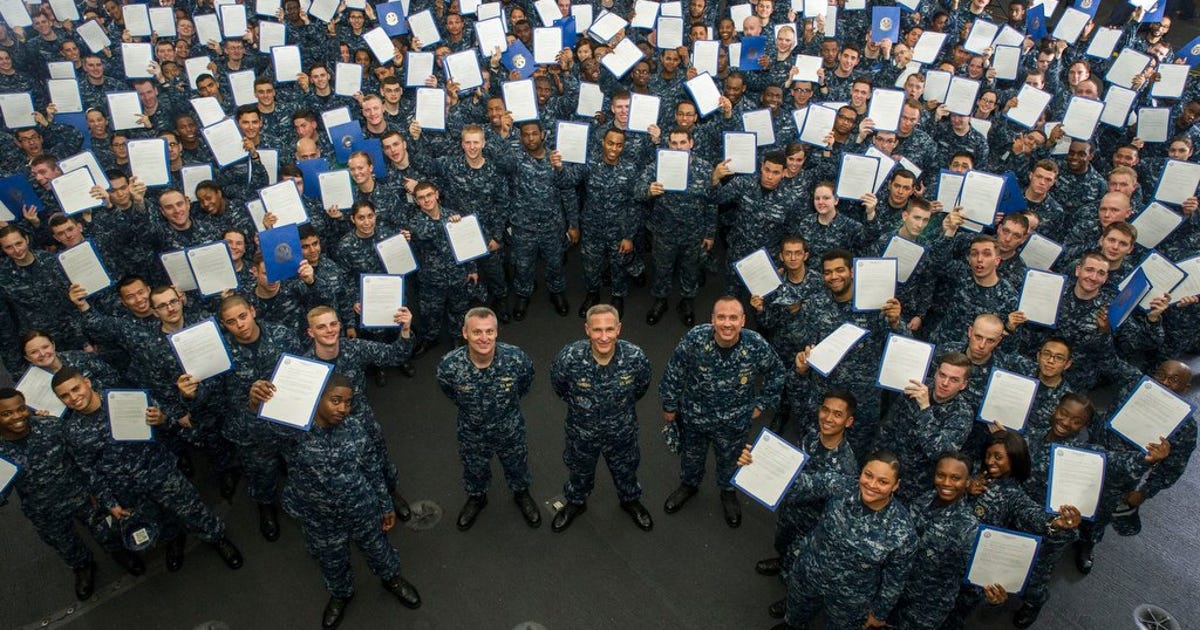Back in the fleet, carrier Ike faces new challenges
By Lance M. Bacon, Staff writer
The aircraft carrier Dwight D. Eisenhower is going from the frying pan into the fire.
Having survived an unprecedented 23-month dry-dock overhaul, the flattop will be the first big deck to go through the new Optimized Fleet Response Plan — an effort that will culminate with a deployment next summer. On top of this, the ship will serve as the runway for the F-35C’s next round of at-sea flight tests in October.
To say the crew has taken these challenges in stride is an understatement. They have amassed a number of awards along the way. These include the 2013 Naval Air Force Atlantic Yellow “E” Award; the 2013 and 2014 Ramage Awards; the 2014 Retention Excellence Award; consecutive Blue “M” Awards; and two consecutive CNO Health Promotion and Wellness Blue “H” Awards with Gold Stars.
Capt. Stephen Koehler, Ike’s commanding officer, credits the chiefs’ mess and department heads for keeping the crew fired up and motivated, despite being extended in the shipyard an extra 10 months.
Being manned before the ship even begins the training cycle — a new requirement for OFR-P that was a difficult hurdle for manpower officials — allows the crew to start training immediately and to gain competence during the work-up cycle. Manning the carrier early is a special challenge while thousands of fleet billets remain open. The plussed-up crew allowed the command to send sailors on temporary assignments to get hands-on experience while the carrier was still in the yards, which is needed to be competitive for advancement.
Their efforts paid off, according to Navy promotion data. While carriers fell below Navy-wide averages in the spring 2015 cycle for third and second class petty officers, the Ike kept an even keel. Despite its long yards period, the ship’s advancement for third and second classes kept pace with Navywide average; they even exceeded the Navywide rate for E-6.
Such rates are not easy during a prolonged yard period. For example, failure rates nearly tripled aboard the decommissioning carrier Enterprise in the past year. Abraham Lincoln, which earlier this year passed the halfway point of its refueling and complex overhaul, scored lower advancement rates for all the petty officer ranks.
Ike was supposed to come out of the yard in August 2014, but was delayed by shipyard issues and a 50 percent increase in unforeseen maintenance (mainly in the propulsion plant) that resulted from back-to-back deployments. Officials at Norfolk Naval Shipyard would not comment on the record-setting dry-docking planned incremental availability, which will carry the 38-year-old flattop through its final 12 years of service.
The carrier received major propulsion plant modernization and repairs. More than 100 tanks, voids and vent plenums were blasted and painted, according to a NNSY release. All shafting and rudders were removed and overhauled, and two sponsons were installed for the Close-In Weapons System. All four catapults were overhauled, and the ship renovated more than 117,000 square feet of spaces that included 25 crew-living compartments and 774 racks. The aft mess decks received a complete overhaul, as did the chiefs mess and forward ward rooms.
The carrier spent the early part of September conducting basic surface operations and deck seamanship and running flight deck and damage control drills. In an Aug. 31 interview with Navy Times, Koehler said he was “more than pleased” with the testing of equipment and upgrades, and considered it “an awesome opportunity to watch the crew rise to the occasion.” More than 60 percent were at sea for the first time, which was evident by their smiles as Ike rocked through high-angle rudder testing at top speeds.
The 2,000 sailors that comprise Carrier Air Wing 3 got underway aboard Ike on Sept. 4. Though they have worked together for the past five months, Koehler said the two commands are working “cautiously yet efficiently” as the new partners accrue shots and traps. The ship looks to achieve its first flight deck certifications since 2009 in mid-September. This will require 120 daytime and 40 nighttime launch and recoveries amid various emergency drills.
The wing includes the “Fighting Swordsmen” of Strike Fighter Squadron 32, the “Gunslingers” of VFA-105, the “Wildcats” of VFA-131 and the “Sidewinders” of VFA-86; the “Zappers” of Electronic Attack Squadron 130; the “Screwtops” of Carrier Airborne Early Warning Squadron 123 and the “Seahawks” of VAW-126; the “Dusty Dogs” of Helicopter Sea Combat Squadron 7; the “Swamp Foxes” of Helicopter Maritime Strike Squadron (HSM) 74; and the “Rawhides” of Fleet Logistics Support Squadron 40.
Ike’s unexpected delay forced fleet bosses in October to swap Ike with aircraft carrier Harry S. Truman, which will deploy this fall, nearly half a year ahead of schedule. Truman in November entered a shortened availability at Norfolk Naval Shipyard, the first performed there, to accommodate the switch. In the meantime, the Eisenhower will spend much of the next nine months at sea in preparation for the ship’s 15th deployment.
“Ike has waited a long time to get back to the fleet, as this crew is ready to go do that,” Koehler said.
Back to Top
